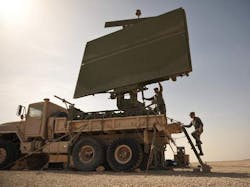Air Force ready to recompete 3DELRR air-defense radar project to defend against enemy missiles and UAVs
HANSCOM AIR FORCE BASE, Mass. – U.S. Air Force tactical radar experts are moving forward with a quick-turnaround plan to recompete an air-defense radar system intended to detect, identify and track enemy missiles as well as manned and unmanned aircraft.
Officials of the Air Force Life Cycle Management Center at Hanscom Air Force Base, Mass., issued a draft solicitation Friday (3DELRR_02) for the Three-Dimensional Expeditionary Long-Range Radar (3DELRR) project, won in 2014 by Raytheon Co.
Even before its award to Raytheon, the 3DELRR program was in hot contention among three of the nation's most prominent radar houses: Raytheon, Northrop Grumman Corp., and Lockheed Martin Corp.
The 3DELRR radar is to replace the Air Force's Northrop Grumman AN/TPS-75 transportable 3-D passive electronically scanned array air search radar for enabling U.S. and allied invasion forces to protect themselves from airborne threats after establishing beachheads.
Raytheon won a potential $71.8 million contract in October 2014 to begin 3DELRR engineering and manufacturing development (EMD). A 2017 $52.7 million contract to the Raytheon Integrated Defense Systems segment in Woburn, Mass., confirmed Raytheon as the 3DELRR prime contractor, and resolved the protests from Raytheon and Lockheed Martin.
Now the Air Force wants to recompete the 3DELRR project because of numerous technical and supplier challenges. Friday's so-called "SpeedDealer" solicitation gives the radar industry another chance to demonstrate a production-ready radar system that can meet or exceed the original 3DELRR requirements.
The Air Force may award as many as three contracts for companies to provide prototype 3DELRR systems. The company with the most promising prototype may receive a contract for as many as 35 3DELRR systems.
Raytheon had proposed a C-band gallium nitride (GaN)-based radar for the original 3DELRR competition. GaN technology helps increase the radar's range, sensitivity, and search capabilities, while operating in C-band offers increased flexibility because that portion of the spectrum is relatively uncongested, Raytheon officials say.
3DELRR is to be the principal Air Force long-range, ground-based sensor for detecting, identifying, tracking, and reporting aerial targets for the Joint Force Air Component Commander through the Theater Air Control System, Air Force officials say.
The 3DELRR system is designed to deal with regional and near-peer conflicts of the future that could involve large numbers of enemy advanced unmanned aerial vehicles (UAVs), fixed-wing aircraft, helicopters, and ballistic and cruise missiles, Raytheon officials say.
3DELRR is designed to detect, identify and track a wide variety of objects accurately at great distances, Raytheon officials say. C-band, moreover, is a relatively uncongested portion of the electromagnetic spectrum. The radar is interoperable with coalition systems and meet the requirements of many foreign militaries, company officials say.
The 3DELRR system is similar to the Ground/Air Task-Oriented Radar (G/ATOR) that Northrop Grumman is building the for U.S. Marine Corps. G/ATOR is being developed to protect Marine Corps expeditionary forces from rockets, artillery, mortars, cruise missiles, UAVs, and other low observables. It is a deployable short-to-medium-range multi-role radar system. 3DELRR, on the other hand, is designed to detect and track threats at longer ranges.
Like 3DELRR, the G/ATOR is based on GaN technology, yet the G/ATOR system is designed to handle air surveillance, weapon cueing, counter-fire target acquisition, and air traffic control for Marine Corps warfighters operating in invasion beaches.
The 3DELRR will provide the Air Force control and reporting center with real-time data to display air activity, and will provide warning and target information.
The system also will provide operators with a precise, real-time air picture to provide air traffic control services to individual aircraft across a wide range of environmental and operational conditions.
The Air Force is asking for industry comments on the 3DELRR draft solicitation by email no later than 25 Feb. 2020 to the Air Force's Kevin Kelleher and Robert Hylton at [email protected].
More information is online at https://beta.sam.gov/opp/49d0291bfb6d4e3a9cb6e43cfc063e85/view.

John Keller | Editor-in-Chief
John Keller is the Editor-in-Chief, Military & Aerospace Electronics Magazine--provides extensive coverage and analysis of enabling electronics and optoelectronic technologies in military, space and commercial aviation applications. John has been a member of the Military & Aerospace Electronics staff since 1989 and chief editor since 1995.

